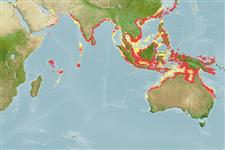>
Carangiformes (Jacks) >
Carangidae (Jacks and pompanos) > Caranginae
Etymology: Alepes: Greek, alepis, -idos = without scales (Ref. 45335).
Eponymy: Jacob Theodor Klein (1685–1759) was a German jurist, historian, botanist, zoologist and mathematician. His publications on fishes include: Historiae Piscium Naturalis promovendae Missus primus Gedani (1744). (Ref. 128868), visit book page.
More on author: Bloch.
Environment: milieu / climate zone / depth range / distribution range
Ökologie
seewasser riff-verbunden; tiefenbereich 5 - 100 m (Ref. 52753). Tropical; 31°N - 26°S, 47°E - 154°E
Indo-West Pacific: Reported from Persian Gulf (Ref. 68964), coastal waters from Pakistan to Sri Lanka; east coast of India, Taiwan Island, Okinawa in Japan, the Philippines, Papua New Guinea and Australia. Records from South Africa, as Caranx kalla, are based on misidentifications of Alepes djedaba.
Length at first maturity / Size / Gewicht / Alter
Maturity: Lm 12.9 range ? - ? cm
Max length : 18.2 cm TL Männchen/unbestimmt; (Ref. 122100); common length : 14.0 cm FL Männchen/unbestimmt; (Ref. 3287)
Adults are found inshore and in coastal waters throughout its range. Feed mainly on planktonic crustaceans and larval fishes. Marketed fresh and dried salted.
Life cycle and mating behavior
Geschlechtsreife | Fortpflanzung | Ablaichen | Eier | Fecundity | Larven
Randall, J.E., 1995. Coastal fishes of Oman. University of Hawaii Press, Honolulu, Hawaii. 439 p. (Ref. 11441)
IUCN Rote Liste Status (Ref. 130435: Version 2024-1)
Bedrohung für Menschen
Harmless
Nutzung durch Menschen
Fischereien: weniger kommerziell
Tools
Zusatzinformationen
Download XML
Internet Quellen
Estimates based on models
Preferred temperature (Ref.
123201): 25.5 - 28.8, mean 27.9 °C (based on 606 cells).
Phylogenetic diversity index (Ref.
82804): PD
50 = 0.5312 [Uniqueness, from 0.5 = low to 2.0 = high].
Bayesian length-weight: a=0.01288 (0.01158 - 0.01433), b=2.96 (2.93 - 2.99), in cm total length, based on LWR estimates for this species (Ref.
93245).
Trophic level (Ref.
69278): 3.5 ±0.41 se; based on food items.
Generation time: 1.3 ( na - na) years. Estimated as median ln(3)/K based on 1
growth studies.
Widerstandsfähigkeit (Ref.
120179): hoch, Verdopplung der Population dauert weniger als 15 Monate. (k >0.30).
Fishing Vulnerability (Ref.
59153): Low vulnerability (16 of 100).
Nutrients (Ref.
124155): Calcium = 113 [66, 232] mg/100g; Iron = 1.21 [0.71, 2.12] mg/100g; Protein = 19.3 [18.2, 20.4] %; Omega3 = 0.165 [0.104, 0.272] g/100g; Selenium = 29.1 [17.2, 54.4] μg/100g; VitaminA = 113 [42, 295] μg/100g; Zinc = 1.39 [0.95, 1.94] mg/100g (wet weight);
